| Pages:
1
2 |
Little_Ghost_again
National Hazard
   
Posts: 985
Registered: 16-9-2014
Member Is Offline
Mood: Baffled
|
|
Haloform with IPA
Hi
First a correction from a post I made a couple of weeks ago.
I stated the sodium hypochlorite I had was 13%, turns out if you read the small print its actually 10%.
Anyway.........
After consultation here it was sugestead I get a small beaker of the chlorite and add a few drops of IPA to see what happens.
I have now done this and the result...... NOTHING. No heat no reaction no any thing.
This was a nearly full 20 ltr container I got my beaker full from, but from the moment I opened the container I had a feeling it was a dead duck,
normally I hate the smell of bleach. This had hardly any smell at all, it had the correct piss like colour but hardly any bleach smell.
I have a vague memory reading somewhere that bleach is temperature sensitive and if it is kept too warm it degrades into.......something else. The
building this was kept in did get warm over the summer, so am I to assume this has now rendered it useless for this reaction? Or maybe IPA isnt going
to work??
Personally I think its the storage of the hyperchlorite that was wrong and it got too warm for too long. I can get some more I guess, but time to save
up again!
Before I start using this neat for cleaning down the pig house are my assumptions correct?
LG
|
|
|
bbartlog
International Hazard
    
Posts: 1139
Registered: 27-8-2009
Location: Unmoored in time
Member Is Offline
Mood: No Mood
|
|
Sodium hypochlorite solution does degrade over time, primarily by way of
3NaOCl -> 2NaCl + NaClO3, but also some decomposition to just NaCl + O2 occurs.
However this is a gradual process that slows as the concentration decreases, and probably doesn't account for your lack of reaction.
I also tried this combination many years ago and observed no change. However, all of the lab preps I have seen since then for oxidizing secondary
alcohols with bleach use acetic acid as well (or a catalyst). See here: http://www.umich.edu/~chem216/216%20S11-Expt%202.pdf
As you can see the acetic acid is present in excess. It appears based on the mechanism outlined in the abovelinked pdf that the issue is simply that
hypochlorous acid (HOCl) is the necessary agent of oxidation here, and that it isn't present as such in appreciable quantities in commercial bleach,
which would be quite basic even if it didn't have added NaOH to stabilize it. Hence the need for acidification.
The less you bet, the more you lose when you win.
|
|
|
Little_Ghost_again
National Hazard
   
Posts: 985
Registered: 16-9-2014
Member Is Offline
Mood: Baffled
|
|
Quote: Originally posted by bbartlog  | Sodium hypochlorite solution does degrade over time, primarily by way of
3NaOCl -> 2NaCl + NaClO3, but also some decomposition to just NaCl + O2 occurs.
However this is a gradual process that slows as the concentration decreases, and probably doesn't account for your lack of reaction.
I also tried this combination many years ago and observed no change. However, all of the lab preps I have seen since then for oxidizing secondary
alcohols with bleach use acetic acid as well (or a catalyst). See here: http://www.umich.edu/~chem216/216%20S11-Expt%202.pdf
As you can see the acetic acid is present in excess. It appears based on the mechanism outlined in the abovelinked pdf that the issue is simply that
hypochlorous acid (HOCl) is the necessary agent of oxidation here, and that it isn't present as such in appreciable quantities in commercial bleach,
which would be quite basic even if it didn't have added NaOH to stabilize it. Hence the need for acidification.
|
My main concern was this stuff normally stinks!! I hate the smell, but tonight I could hardly detect any bleach like smell.
Fortunately we use loads of this stuff, so it will be used with less dilution than normal. I will wait until dad gets some more and use some fresh
stuff. I will also try the acetic acid.
I prefer that to the easy option of changing solvent, Full report back on results and many thanks for the info
LG
|
|
|
Amos
International Hazard
    
Posts: 1406
Registered: 25-3-2014
Location: Yes
Member Is Offline
Mood: No
|
|
For the record, a few drops isn't going to cut it. Chloroform is somewhat soluble in water, and the yield is lower than you'd think. You won't get
that much of a warming reaction either with small amounts(and it also takes some time to initiate). I'm going to try the same thing tonight to see if
maybe it works with bleach of a confirmed purity, in case yours has gone bad.
|
|
|
Amos
International Hazard
    
Posts: 1406
Registered: 25-3-2014
Location: Yes
Member Is Offline
Mood: No
|
|
Okay, so I tried my own haloform reaction with IPA to see if your results were correct, Little Ghost. I chilled 100ml of 8.25% NaClO to nearly
freezing, added 10ml of dry isopropanol, and left it alone for a bit. Five minutes later, the liquid was cloudy, but there was no separation of layers
and it wasn't any warmer than 5 minutes at room temperature would make it. I tried adding 2 ml glacial acetic acid to catalyze the reaction. All I got
was a whiff of chlorine; no reaction seems to have taken place the whole time.
|
|
|
bbartlog
International Hazard
    
Posts: 1139
Registered: 27-8-2009
Location: Unmoored in time
Member Is Offline
Mood: No Mood
|
|
2ml of glacial acetic acid is not enough to acidify 100ml of 8.25% bleach, and you have too much isopropanol for the haloform reaction to complete.
Oxidation to acetone would roughly deplete the hypochlorite, with none left for the rest of the reaction. You have approximately 125mmol of NaOCl
there (and there is a little added NaOH to make it more alkaline, too). If you want to do the haloform reaction starting from IPA, you need a 4:1 mole
ratio of NaOCl to IPA, so you would only be looking at 2.3 ml of IPA (30mmol). And you would want maybe 150-200mmol of acetic acid, i.e. something
more like 10-12ml (but even that might not be enough ... maybe try one of the published preparations??).
You will waste a lot less time if you do some stoichiometric calculation beforehand.
[Edited on 18-9-2014 by bbartlog]
[Edited on 18-9-2014 by bbartlog]
The less you bet, the more you lose when you win.
|
|
|
Little_Ghost_again
National Hazard
   
Posts: 985
Registered: 16-9-2014
Member Is Offline
Mood: Baffled
|
|
thanks guys.
We will be getting some more soon, mine didnt go cloudy! I will also grab some acetic acid.
I am determined to get it work 
|
|
|
Little_Ghost_again
National Hazard
   
Posts: 985
Registered: 16-9-2014
Member Is Offline
Mood: Baffled
|
|
WELL UPDATE!!!!
I know I shouldnt do things the way I do, but this was just a test.........
The beaker was just a test, the idea was put a little IPA in a Beaker of hypochlorite and see if it got hot.
Well it didnt.
So last night I thought I would 'just see' if adding Sodium hydroxide would salt out the IPA.
I will post pics after School but I am not sure what I have................................
The beaker is a clittle cloudy but there are clear droplets on the bottom of the beaker that dont look like IPA (kind of too shiny).
Obviously I have no idea how much IPA or Hydroxide I added  . It was a kind of I
wonder what sort of thing..... OK I foofed up I didnt measure and I should have full stop. . It was a kind of I
wonder what sort of thing..... OK I foofed up I didnt measure and I should have full stop.
Actually I will go take a pic now, I guess best way is decant everything into a sep funnel. Now I am not convinced this is anything but IPA on the
bottom, but the beaker smells different this morning, it smells slightly sweet. BRB with a pic
|
|
|
Little_Ghost_again
National Hazard
   
Posts: 985
Registered: 16-9-2014
Member Is Offline
Mood: Baffled
|
|
Well the pic is rubbish, but the spot in it is very clear and shiny in real life, it didnt come out too good in the pic, I took a little off the
bottom via pipette and it is definitely NOT IPA!!
I have never smelled Chloroform but dad has and he says he is sure that it what it is, its very sweet smelling  . So tonight I will try and recreate (why the foof dont I do it right the first time). All I had to do was measure! . So tonight I will try and recreate (why the foof dont I do it right the first time). All I had to do was measure!
Anyway try adding some hyperchlorite crystals (just a few) and leave.
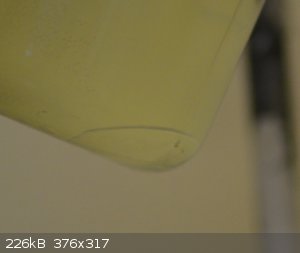
|
|
|
Little_Ghost_again
National Hazard
   
Posts: 985
Registered: 16-9-2014
Member Is Offline
Mood: Baffled
|
|
Well late for School!
Did one other quick experiment, I was almost convinced that it was just IPA salted out with the added Hydroxide, so I added a drop more hydroxide and
more IPA, its gone slightly cloudy again (not as much), BUT the IPA is sitting in a nice clear layer on the TOP!!!!
So surely the bottom blob of sparkly clear liquid is chloroform? What I dont get is the bleach had hardly any smell, no heat was detected, nothing
happened at all until I added a small amount of sodium hydroxide, the hydroxide I added was some of the liquid from the crystals that had melted in
the air.
I am So annoyed I just did a 'quick test'.
So tonight I will use hypochlorite from the same drum as before, and this time weigh and measure everything. Hopefully I can get it to work again.
How do you test for Chloroform?
So far all I have done is place 3 drips from a burette into a watch glass and 3 drips of IPA into another.
The blob evaporated way way quicker than the IPA.
|
|
|
Amos
International Hazard
    
Posts: 1406
Registered: 25-3-2014
Location: Yes
Member Is Offline
Mood: No
|
|
Quote: Originally posted by bbartlog  |
2ml of glacial acetic acid is not enough to acidify 100ml of 8.25% bleach, and you have too much isopropanol for the haloform reaction to complete.
Oxidation to acetone would roughly deplete the hypochlorite, with none left for the rest of the reaction. You have approximately 125mmol of NaOCl
there (and there is a little added NaOH to make it more alkaline, too). If you want to do the haloform reaction starting from IPA, you need a 4:1 mole
ratio of NaOCl to IPA, so you would only be looking at 2.3 ml of IPA (30mmol). And you would want maybe 150-200mmol of acetic acid, i.e. something
more like 10-12ml (but even that might not be enough ... maybe try one of the published preparations??).
You will waste a lot less time if you do some stoichiometric calculation beforehand.
[Edited on 18-9-2014 by bbartlog]
[Edited on 18-9-2014 by bbartlog] |
Well I wasn't trying to produce chloroform for use(I've got enough of that already, believe me), though I admit it was poorly executed. I wanted to
see if it was a more-or-less straightforward reaction like that of acetone, and follow steps similar to Little Ghosts's first attempt(because he was
concerned something was off with his bleach). Unfortunately I didn't read your post all the way through, or I would've known to completely acidify the
mixture, which would've required calculations and ultimately probably would've lead to success.
|
|
|
Amos
International Hazard
    
Posts: 1406
Registered: 25-3-2014
Location: Yes
Member Is Offline
Mood: No
|
|
Quote: Originally posted by Little_Ghost_again  |
So tonight I will use hypochlorite from the same drum as before, and this time weigh and measure everything. Hopefully I can get it to work again.
How do you test for Chloroform?
So far all I have done is place 3 drips from a burette into a watch glass and 3 drips of IPA into another.
The blob evaporated way way quicker than the IPA. |
For someone that hasn't dealt with chloroform, the way you describe it definitely sounds like your reaction worked! The lack of warming is strange,
though; even when I've used frozen sodium hypochlorite in the past the reaction vessel became warm, almost hot to the touch. I think I'm going to try
to redo it with the proper figures using simple household vinegar instead of glacial, that way it may actually be a functional synthesis for those
that can't get their hands on acetone or GAA.
|
|
|
Praxichys
International Hazard
    
Posts: 1063
Registered: 31-7-2013
Location: Detroit, Michigan, USA
Member Is Offline
Mood: Coprecipitated
|
|
Since hypochlorite solutions are sold at low concentrations to help reduce decomposition, it is only making a bad yield worse by relying on
hypochlorite to both oxidize the isopropanol to acetone and then generate chloroform from the acetone.
My advise: find some acetone! There is no need to acidify - just add the stoicheometric amount of acetone in two portions to a frozen jug of (I use
12.5%) NaClO solution, with re-freezing between additions. (Be careful - this is VERY exothermic - it takes about 90 seconds to go from frozen to
warm. Adding it all at once DOES result in boiling) Let it warm to room temperature, and there will be a mess of chloroform beads on the bottom. Pour
off ~90% the waste, then use a sep funnel to finish out the separation. Dry the chloroform over MgSO4 and distill.
Each gallon is going to give you something like 180ml of chloroform after losses, even if you do it sloppy and quickly like I do.
That said, I can make a liter of chloroform in an afternoon, at the cost of about $18. Check out my YouTube video.
|
|
|
Little_Ghost_again
National Hazard
   
Posts: 985
Registered: 16-9-2014
Member Is Offline
Mood: Baffled
|
|
Ok back from School, Before I left this morning I added a little more IPA, it clearly floated on the top in a layer 2 cm deep. Soooo I added more
bleach and a drop more sodium Hydroxide.
The sodium hydroxide was actually the solution that was in a bowl from some sodium hydroxide crystals that had been left in the air.
I am totally sure the hypochlorite isnt as good as it was, a quick test and not conclusive but.... I had a T shirt that was splashed several months
ago from this very drum, within moments it had bleached the colour out. So i got same T shirt (It's a favorite so I kept it) and dropped several drips
on the T shirt.
The colour did bleach out but took ages and isnt as white!
Anyway....................
The moment I added the sodium hydroxide the IPA layer went and the solution became cloudy, I have had a electronic data logger on the beaker all day.
after 26 mins this morning the beaker rose 3C from room temp, it has remained 3c higher all day and is still cloudy.
I am going to weigh and redo the whole thing later, but The whole point of this was to try without acetone. Nothing at all happened to the solution
until I added the sodium hydroxide. I have no idea what that has to do with the reaction, I added it simply to see what would happen. To be honest my
thinking went like this...... Ok hyperchlorite solution foofed, so probably now contains water/saltwater.
If it contains water then I can add some hydroxide and feel the heat from the reaction of sodium hydroxide with water, if its salt water then there is
a chance sodium chloride with drop out as crystals (ive been playing with salt).
To my surprise none of that happened! instead my clear bleach/IPA solution went cloudy, I went to bed last night and left it like that. This morning I
got up and the solution was almost clear with this really clear blob on the bottom of the beaker.
Now there was only around 300 ml in the beaker, so the size of blob made me think it was IPA. Mainly because it seems alot of chloroform from what I
am pretty sure is now weakish bleach.
I have no idea what ratio's to use or anything, but at this point I dont want to know. instead I am going to do it by eye but measure the amounts. I
will update later.
The pic was taken in a hurry and against a non white wall, it dosnt show how clear and sparkly the blob is. Also it smelled really sweet and a bit
sickly, I am not sure I like the smell but its certainly wasnt IPA.
Also I put a drop on a watch glass and it evaporated much faster than a drop of IPA i put on another one.
|
|
|
Little_Ghost_again
National Hazard
   
Posts: 985
Registered: 16-9-2014
Member Is Offline
Mood: Baffled
|
|
I didnt add any acid! I might do one with some vinegar and citric acid (its all I have ).
I will report back later
|
|
|
Little_Ghost_again
National Hazard
   
Posts: 985
Registered: 16-9-2014
Member Is Offline
Mood: Baffled
|
|
Ok I scaled up a little bit.
502g of sodium hypochlorite
102g of IPA
90g of Sodium hydroxide
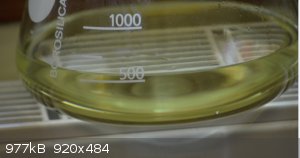
The hypochlorite
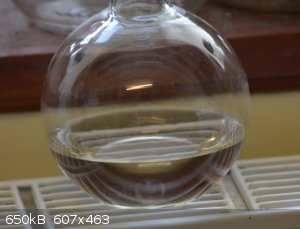
The ipa
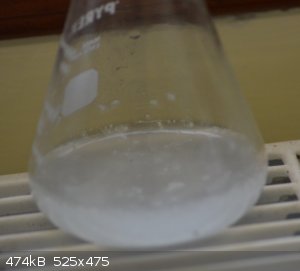
The Hydroxide
this next pic is the hypochlorite mixed in with the IPA and shaken well, all chems at room temp (15.1c). Look close you might see the distinct layer
of IPA on top
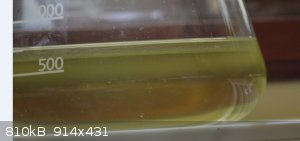
Then I waited 15 mins with no change and added the sodium hydroxide, this is the next pic
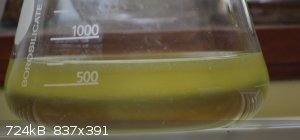
It began to cloud straight away and temp after 5 mins rose to 25.2C and so far is stuck there, I will take the temp as and when I can and report any
changes.
As a side note the beaker I left this morning is now looking like this
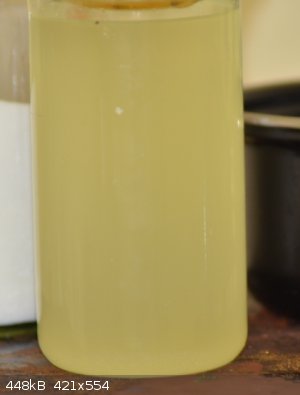
What you cant seee in the pic is more beads of hopefully chloroform that are on the bottom, the beaker is sat at 18C
|
|
|
Amos
International Hazard
    
Posts: 1406
Registered: 25-3-2014
Location: Yes
Member Is Offline
Mood: No
|
|
Normally, I'd say your addition of sodium hydroxide to the mix may have salted out the IPA you added; traditionally that's what you'd use if you
wanted to remove the water from IPA. But the Isopropanol in that case would float to the TOP. If you've got something in there DENSER than water, I'm
inclined to say you might've made chloroform, especially that note you made about how much clearer/shinier it was.
Here's a picture I took with the more typical acetone/hypochlorite haloform reaction, if this is what yours looks like I'd say you've got what you
were after: http://sciencemadness.wikia.com/wiki/Chloroform?file=Chlorof...
Quote: Originally posted by Praxichys  | Since hypochlorite solutions are sold at low concentrations to help reduce decomposition, it is only making a bad yield worse by relying on
hypochlorite to both oxidize the isopropanol to acetone and then generate chloroform from the acetone.
My advise: find some acetone! There is no need to acidify - just add the stoicheometric amount of acetone in two portions to a frozen jug of (I use
12.5%) NaClO solution, with re-freezing between additions. (Be careful - this is VERY exothermic - it takes about 90 seconds to go from frozen to
warm. Adding it all at once DOES result in boiling) Let it warm to room temperature, and there will be a mess of chloroform beads on the bottom. Pour
off ~90% the waste, then use a sep funnel to finish out the separation. Dry the chloroform over MgSO4 and distill.
Each gallon is going to give you something like 180ml of chloroform after losses, even if you do it sloppy and quickly like I do.
That said, I can make a liter of chloroform in an afternoon, at the cost of about $18. Check out my YouTube video. |
I did check your video, by the way(https://www.youtube.com/watch?v=37m_kMK7Po0), but you said in the video you only got about 100ml per gallon of sodium hypochlorite solution, which
is kind of far away from 180ml. I'm not saying this to tell you that you're wrong; rather, I was wondering if the number you gave was a mistake, or if
there's something different you're doing currently that gives you a higher yield? Using 8.25% NaClO I typically get about 70-80ml per jug.
|
|
|
Little_Ghost_again
National Hazard
   
Posts: 985
Registered: 16-9-2014
Member Is Offline
Mood: Baffled
|
|
Quote: Originally posted by No Tears Only Dreams Now  | Normally, I'd say your addition of sodium hydroxide to the mix may have salted out the IPA you added; traditionally that's what you'd use if you
wanted to remove the water from IPA. But the Isopropanol in that case would float to the TOP. If you've got something in there DENSER than water, I'm
inclined to say you might've made chloroform, especially that note you made about how much clearer/shinier it was.
Here's a picture I took with the more typical acetone/hypochlorite haloform reaction, if this is what yours looks like I'd say you've got what you
were after: http://sciencemadness.wikia.com/wiki/Chloroform?file=Chlorof...
Quote: Originally posted by Praxichys  | Since hypochlorite solutions are sold at low concentrations to help reduce decomposition, it is only making a bad yield worse by relying on
hypochlorite to both oxidize the isopropanol to acetone and then generate chloroform from the acetone.
My advise: find some acetone! There is no need to acidify - just add the stoicheometric amount of acetone in two portions to a frozen jug of (I use
12.5%) NaClO solution, with re-freezing between additions. (Be careful - this is VERY exothermic - it takes about 90 seconds to go from frozen to
warm. Adding it all at once DOES result in boiling) Let it warm to room temperature, and there will be a mess of chloroform beads on the bottom. Pour
off ~90% the waste, then use a sep funnel to finish out the separation. Dry the chloroform over MgSO4 and distill.
Each gallon is going to give you something like 180ml of chloroform after losses, even if you do it sloppy and quickly like I do.
That said, I can make a liter of chloroform in an afternoon, at the cost of about $18. Check out my YouTube video. |
I did check your video, by the way(https://www.youtube.com/watch?v=37m_kMK7Po0), but you said in the video you only got about 100ml per gallon of sodium hypochlorite solution, which
is kind of far away from 180ml. I'm not saying this to tell you that you're wrong; rather, I was wondering if the number you gave was a mistake, or if
there's something different you're doing currently that gives you a higher yield? Using 8.25% NaClO I typically get about 70-80ml per jug.
|
Wow looks like thats it! your pic like mine dosnt exactly show how....sparkly and blueish it can make the light (I cant think how to describe it), but
I am sure its the same.
UPDATE
Things didnt look right and temperature dropped to 20c, so I added another 1050g of hypochlorite. Temp gone back up to 25c.
I have put the beaker solution (most of it) into a sep funnel, its still reacting slightly and the temp is 18.9c room temp 15.2c
Here is a pic of it, again the pic dosnt do it justice, my problem with the camera is its set on RAW files (its not mine), its a Nikon D7000 so the
files should be tweaked first in photoshop or the camera placed in JPEG mode.
I dont know how to do that. so I take a pic then do a screen shot of the file after loading it into the laptop, so you see a screen shot of a RAW file
with no colour compensation, I will get dad to take the pics later its his camera. Then you can see what I mean by shiny.
Anyway considering its still going and the beaker is only 400ml, If it is Chloroform then the yield to me seems good, especially as the hypochlorite
isnt the 10% it should be.
Is there anyway for me to titrate the strength with a acid like citric? I dont have much in the way of acids yet. in fact until I sort proper locked
cupboards my chemicals are limited
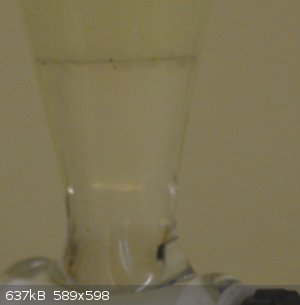
|
|
|
Little_Ghost_again
National Hazard
   
Posts: 985
Registered: 16-9-2014
Member Is Offline
Mood: Baffled
|
|
I am 100% its not IPA. It might not be Chloroform but its certainly Not IPA, if you add IPA to a small amount of liquid from the original beaker then
it floats. Plus IPA isnt sparkly, Also it moves almost like a blob! if you shake it then it separates into tiny beads that quickly find each other, it
dosnt sit in a layer in the beaker its more of a slight dome (blob is the only way I can think of it).
EDIT!!!
Dads just got home with 50ml of chloroform from work and some drosophila melanagasta (fruit flies to you and me).
He used it to knock them out and they recovered in the same amount of time as the lab grade Chloroform. We tried knocking some out with IPA.....
If they were bigger I would dig a hole for them! So apart from how it looks, it knocks out fruit flies and they can recover, the time to knock them
out is the same (roughly) as the lab stuff.
I am well Chuffed. Beaming in fact
[Edited on 18-9-2014 by Little_Ghost_again]
|
|
|
Actinium
Hazard to Self
 
Posts: 67
Registered: 2-9-2014
Member Is Offline
Mood: synthetic
|
|
just had a question since we are on the topic?
I wanted to try the Haloform and wanted to use acetone with the 3:1 ratio. Is it crucial to round up/down when figuring molarity? I can't exactly
remember where I read it on one of the posts on this board that even slight excess of acetone isn't helpful but actually counter productive?
I ask because I'm second guessing myself on my calculations and wanted to know if I was say, 1/2ml-1ml under stoichiometric amounts with the Acetone,
would the reaction still proceed?
|
|
|
aga
Forum Drunkard
    
Posts: 7030
Registered: 25-3-2014
Member Is Offline
|
|
Congratulations !
Your post spurred me to try the haloform reaction too, with acetone.
Today there is a pea-sized drop of something Clear in the bottom of a beaker.
Also 4 other beakers with various quantities of acetone to see what happens.
No fruit flies to titrate it with though.
|
|
|
Little_Ghost_again
National Hazard
   
Posts: 985
Registered: 16-9-2014
Member Is Offline
Mood: Baffled
|
|
When I get acetone I will try with that. I will see tomorrow what I get with this new batch. If I get another result then I need to learn how to work
out Mols etc and start experimenting, what I like so far is in the first beaker I did I hardly used any IPA, the hypochlorite is meant to be 10% but
without doubt it has degraded.
I use this brand a great deal at home because my jobs include cleaning out various animal buildings etc and when I clean other peoples tractors they
get the wheels etc sprayed first at the bottom of the drive way (bio security). So I know how it normally smells and it is way way stronger than this
one. Its made by a good company (Diversey lever), this drum was at the very back of a building and had previously been opened and part used.
The building got used to store some equipment and it made it hard to get to the drum, so it got left there and I used other drums. I could do with
knowing if I can titrate the hypo with a acid like citric. That way I can tell what the yield is.
I think the yield has been good considering all the factors, also I havnt had to cool anything! everything has started at around 15c and so far not
gone over 25c.
Anyway is alot of fun experimenting with!
|
|
|
aga
Forum Drunkard
    
Posts: 7030
Registered: 25-3-2014
Member Is Offline
|
|
Mols are pretty straighforward.
Best to think of a simple example, have a go at working out yourself, then start a new thread about that.
You'll 'Get It' in minutes, and then forevermore be able to work out the stoichometric amounts for any reaction.
|
|
|
Little_Ghost_again
National Hazard
   
Posts: 985
Registered: 16-9-2014
Member Is Offline
Mood: Baffled
|
|
UPDATE
Temperature risen to 28.9c (all temps taken with IR temp gun). I have a 2 Ltr conical flask with a cotton wool stopper.
Flask gently swirled 4-5 times, stopper removed and contents sniffed (wafted). Strange smell............ IPA I would describe as a Blunt/rough kind of
smell and very distinctive, this smell from the flask dosnt smell like chloroform (yet) and no droplets of chloroform are visible, however the smell
has a much more sweet/sickly smell that I would describe as aromatic and lingering, it leaves a taste in the back of the throat for a fairly long time
>10 mins.
Smells volatile and unlike IPA is apparent as soon as the flask is opened.
While I am pretty sure this will give chloroform in the end, I want to redo tomorrow and remove a few more unknowns. For example the hydroxide liquid
is a few days old and is simply sodium hydroxide prills that have reacted with the air, no water has been added intentionally.
So I have no idea of the composition of this liquid and no idea of concentration etc.
Tomorrow when I repeat I will use dry prills and make a solution (molar strength undecided at this point) .
I would really appreciate some help tomorrow in working out what reactions are taking place and what the end products are likely to be. Apart from the
target compound (Chloroform) I am interested if anything else can be extracted from the liquid that is decanted from the Chloroform.
I am reading up on equations etc but at present I am at a very early stage in understanding. I know this amount of hand holding is a PITA, but it
would be really appreciated  . .
I dont need it for this current experiment, this was more to do with seeing if I could repeat last nights.
I am also looking into how I can calculate the strength of hypochlorite as it is, in its current form.
It is a fascinating process, I am surprised at the lack of heat, I would have expected far more, even if purely from adding hydroxide. If I can get
this working correctly and a decent yield then for me its a better way than Acetone. It also seems to not require any form of temperature control (so
far).
|
|
|
aga
Forum Drunkard
    
Posts: 7030
Registered: 25-3-2014
Member Is Offline
|
|
IR temp guns aren't too reliable.
I got one, and thought it was Ace until i got a few mercury and alcohol thermometers.
For your next Haloform, do the maths first as bbartlog suggested.
It's true what bbartlog says: it saves a hell of a lot of time when you know the correct amounts of reactants.
As i understand it, this Haloform reaction is multi-step and more complicated than A+B = C.
For working out the required quantities (AKA stoichimetry) all you need is the Reactants (chemicals before reacting them together) and the Products
(stuff you wanna make).
Having to have the right environment, and needing NaOH as well complicates it a bit.
Need help from an OC chemist here who knows this reaction, and can give you the Formula so you can do the stoichiometric calculations.
Anybody ?
P.S. pronunciation guide :-
stoichimetry = Stoy-ee Kim Ettry
stoichiometric = Stoy Key O Metric.
It's all just Greek and Latin to keep us all confused all the time, and keep uneducated plebs out.
E.g. 'Hydro Gen' is ancient Greek for 'Water Creator', etymylogically.
'Etymology' is also derived from ancient Greek, originally meaning Truth, then Seeker of truth, and altered via French then into English to mean 'The
[truth of the] Origin of a Word'.
All specialist fields have their own sub-languages.
The Posher ones use Greek and Latin, the Peasant ones make up new words, like 'spindle'.
|
|
|
| Pages:
1
2 |